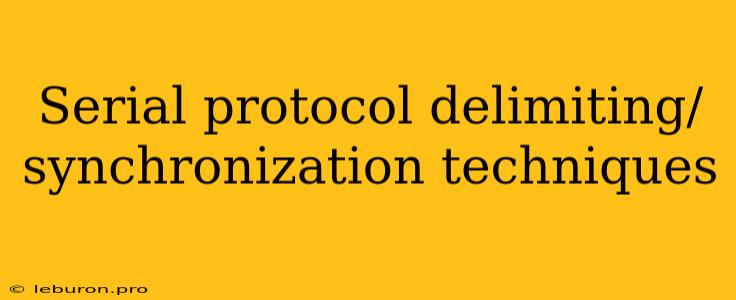Serial communication, a fundamental aspect of modern electronics, enables the transmission of data over a single channel. However, the efficient and reliable exchange of information demands a robust mechanism for data organization and synchronization. This is where serial protocol delimiting/synchronization techniques come into play, ensuring that data is correctly interpreted by both the sender and receiver. These techniques are crucial for ensuring that the data is transmitted and received without errors. They also allow for the detection of any data corruption that may have occurred during transmission.
Serial Protocol Delimiting/Synchronization Techniques
Serial communication relies on the precise timing and ordering of data bits. To differentiate individual data packets within a continuous stream, various serial protocol delimiting/synchronization techniques are employed. These techniques act as markers, signaling the start and end of data packets, thereby maintaining data integrity and enabling seamless communication.
Start and Stop Bits
One of the simplest serial protocol delimiting/synchronization techniques is the use of start and stop bits. Each data byte is preceded by a start bit and followed by a stop bit, effectively framing the data. The start bit, typically a logic low, signals the beginning of data transmission, while the stop bit, usually a logic high, marks the end. This technique is particularly suitable for asynchronous serial communication, where the sender and receiver do not operate from a shared clock.
Synchronization Characters
In addition to start and stop bits, synchronization characters, also known as delimiters, can be used to separate data packets. These characters are unique patterns that are not part of the actual data stream and serve as markers for the receiver. For example, the ASCII character 0x02 (STX - Start of Text) can be used to indicate the beginning of a data packet, and 0x03 (ETX - End of Text) can signify the end. By recognizing these synchronization characters, the receiver can correctly interpret the incoming data.
Parity Bits
Parity bits are used for error detection rather than direct delimiting. They are added to each data byte and provide a simple way to check if the data has been corrupted during transmission. There are two types of parity: even and odd. In even parity, the number of 1 bits in a data byte, including the parity bit itself, should be even. In odd parity, the total number of 1 bits should be odd. If the parity bit is incorrect, the receiver knows that an error has occurred.
Preamble and Postamble
In synchronous serial communication, where the sender and receiver are synchronized using a shared clock, preamble and postamble sequences are often employed. The preamble is a series of bits sent before the actual data, while the postamble follows the data. These sequences help the receiver synchronize its clock with the sender's clock and are essential for maintaining data integrity during long transmissions.
Framing Techniques
Framing techniques provide a structured way to delimit data packets in serial communication. One common technique is byte-oriented framing, where each data packet consists of a fixed number of bytes. This technique is straightforward and efficient for short data packets, but can become inefficient for large data packets.
Another framing technique is bit-oriented framing, where data packets are divided into variable-length frames. This technique is more flexible than byte-oriented framing and is commonly used in protocols like HDLC (High-level Data Link Control).
Other Techniques
In addition to the techniques mentioned above, various other serial protocol delimiting/synchronization techniques are used in specific applications. These include:
- Manchester Encoding: In this technique, each data bit is represented by a transition in the signal, either from low to high or vice versa, providing both clocking and data information. This eliminates the need for separate clock signals, but requires higher bandwidth.
- Differential Manchester Encoding: This technique uses a transition in the middle of each bit period for clocking, while the data is encoded by the level of the signal at the beginning of each bit period. This offers increased robustness to noise.
- 8b/10b Encoding: This technique encodes 8 data bits into 10 bits, introducing special codes for synchronization and error detection. It is commonly used in high-speed applications like Gigabit Ethernet.
Conclusion
Serial protocol delimiting/synchronization techniques play a vital role in ensuring the reliable transmission of data in serial communication. These techniques help differentiate data packets, maintain data integrity, and enable error detection. Choosing the appropriate technique depends on factors like the type of serial communication (synchronous or asynchronous), the required data rate, and the desired level of error detection. By understanding and implementing these techniques, developers can create robust and reliable serial communication systems that meet the demands of various applications.
